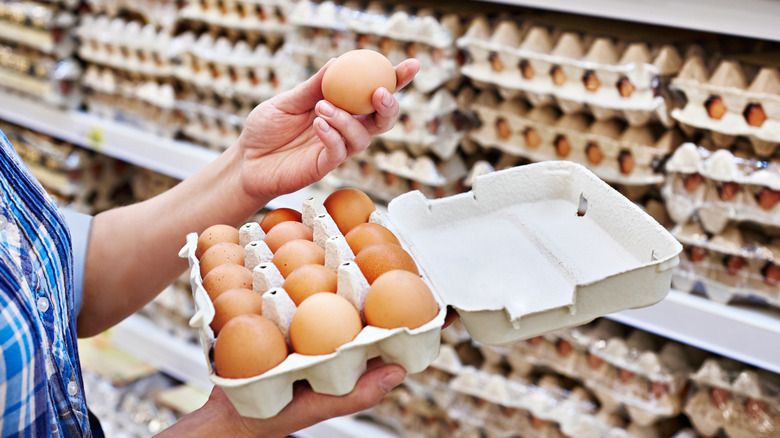The Price Of Eggs In The '50s Compared To Today Is Staggering
The price of a carton of eggs has been a benchmark for grocery prices for decades, but in the early springtime of 2025, egg prices received an even brighter spotlight. According to AP News, the average price of a dozen grade A large eggs in the U.S. reached a staggering $6.23, quite a shift from the sub $2 prices you could catch in 2021. Continue tracing back in time, and while there are outliers, the prices are significantly lower, especially when you hit the 1950s.
Back when the food trends included dishes like deviled eggs and baked Alaska, you could buy eggs for as low as 29 cents a dozen in May of 1959 — per a U.S. Department of Agriculture report in Washington state. To be fair, it's necessary to adjust figures for general inflation, as spending power perpetually evolves. Referencing the CPI Inflation Calculator provided by the U.S. Bureau of Labor Statistics, the same 29 cent egg dozen translates to $3.25 today; showcasing the foodstuff didn't feel like much of a bargain back then, either. So while 1950s egg prices certainly catch the eye, you'll need to unscramble the full truth.
Egg prices are prone to volatility
With consumers asking if it's more affordable to buy eggs or the actual chickens, the foodstuff's steep pricing feels like a modern issue. It was initially reported that an outbreak of the bird flu caused the 2025 price hike, yet later investigation revealed corporate greed excarbated the issue.
Unfortunately, such fluctuating egg price developments are nothing new. The U.S. Department of Agriculture report outlines that a dozen eggs in September 1958 cost 46 cents — over a 50% increase from their 1959 low. Plus, the price reached as high as 61 cents in August of 1953. Examine the market average further into the 20th century, and while there's a gradual increase, the correlation's not so clear cut.
Turns out, egg costs have long troubled consumers. In December 1949, the U.S. government stabilized costs by way of a surplus, establishing a minimum price. Yet a few years down the line in 1957-1958, grocery prices experienced an upward surge of 7%, before calming down again, via the U.S. Bureau of Labor Statistics. Among all grocery categories, eggs top volatility, explains the USDA. So combine market tension, occasional viral outbreaks, and the foodstuff's complex supply chain, and you get intense pricing fluctuations. If you're feeling frustrated regarding all the drama, take solace that egg cost swings have been around for decades.


